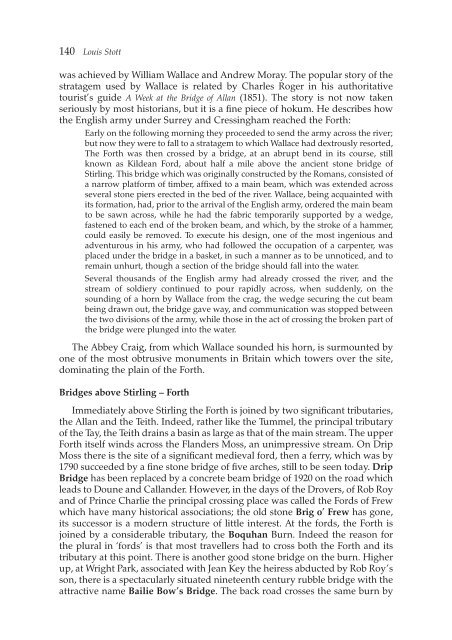the Forth Naturalist Historian - Forth Naturalist and Historian ...
the Forth Naturalist Historian - Forth Naturalist and Historian ...
the Forth Naturalist Historian - Forth Naturalist and Historian ...
You also want an ePaper? Increase the reach of your titles
YUMPU automatically turns print PDFs into web optimized ePapers that Google loves.
140 Louis Stott<br />
was achieved by William Wallace <strong>and</strong> Andrew Moray. The popular story of <strong>the</strong><br />
stratagem used by Wallace is related by Charles Roger in his authoritative<br />
tourist’s guide A Week at <strong>the</strong> Bridge of Allan (1851). The story is not now taken<br />
seriously by most historians, but it is a fine piece of hokum. He describes how<br />
<strong>the</strong> English army under Surrey <strong>and</strong> Cressingham reached <strong>the</strong> <strong>Forth</strong>:<br />
Early on <strong>the</strong> following morning <strong>the</strong>y proceeded to send <strong>the</strong> army across <strong>the</strong> river;<br />
but now <strong>the</strong>y were to fall to a stratagem to which Wallace had dextrously resorted,<br />
The <strong>Forth</strong> was <strong>the</strong>n crossed by a bridge, at an abrupt bend in its course, still<br />
known as Kildean Ford, about half a mile above <strong>the</strong> ancient stone bridge of<br />
Stirling. This bridge which was originally constructed by <strong>the</strong> Romans, consisted of<br />
a narrow platform of timber, affixed to a main beam, which was extended across<br />
several stone piers erected in <strong>the</strong> bed of <strong>the</strong> river. Wallace, being acquainted with<br />
its formation, had, prior to <strong>the</strong> arrival of <strong>the</strong> English army, ordered <strong>the</strong> main beam<br />
to be sawn across, while he had <strong>the</strong> fabric temporarily supported by a wedge,<br />
fastened to each end of <strong>the</strong> broken beam, <strong>and</strong> which, by <strong>the</strong> stroke of a hammer,<br />
could easily be removed. To execute his design, one of <strong>the</strong> most ingenious <strong>and</strong><br />
adventurous in his army, who had followed <strong>the</strong> occupation of a carpenter, was<br />
placed under <strong>the</strong> bridge in a basket, in such a manner as to be unnoticed, <strong>and</strong> to<br />
remain unhurt, though a section of <strong>the</strong> bridge should fall into <strong>the</strong> water.<br />
Several thous<strong>and</strong>s of <strong>the</strong> English army had already crossed <strong>the</strong> river, <strong>and</strong> <strong>the</strong><br />
stream of soldiery continued to pour rapidly across, when suddenly, on <strong>the</strong><br />
sounding of a horn by Wallace from <strong>the</strong> crag, <strong>the</strong> wedge securing <strong>the</strong> cut beam<br />
being drawn out, <strong>the</strong> bridge gave way, <strong>and</strong> communication was stopped between<br />
<strong>the</strong> two divisions of <strong>the</strong> army, while those in <strong>the</strong> act of crossing <strong>the</strong> broken part of<br />
<strong>the</strong> bridge were plunged into <strong>the</strong> water.<br />
The Abbey Craig, from which Wallace sounded his horn, is surmounted by<br />
one of <strong>the</strong> most obtrusive monuments in Britain which towers over <strong>the</strong> site,<br />
dominating <strong>the</strong> plain of <strong>the</strong> <strong>Forth</strong>.<br />
Bridges above Stirling – <strong>Forth</strong><br />
Immediately above Stirling <strong>the</strong> <strong>Forth</strong> is joined by two significant tributaries,<br />
<strong>the</strong> Allan <strong>and</strong> <strong>the</strong> Teith. Indeed, ra<strong>the</strong>r like <strong>the</strong> Tummel, <strong>the</strong> principal tributary<br />
of <strong>the</strong> Tay, <strong>the</strong> Teith drains a basin as large as that of <strong>the</strong> main stream. The upper<br />
<strong>Forth</strong> itself winds across <strong>the</strong> Fl<strong>and</strong>ers Moss, an unimpressive stream. On Drip<br />
Moss <strong>the</strong>re is <strong>the</strong> site of a significant medieval ford, <strong>the</strong>n a ferry, which was by<br />
1790 succeeded by a fine stone bridge of five arches, still to be seen today. Drip<br />
Bridge has been replaced by a concrete beam bridge of 1920 on <strong>the</strong> road which<br />
leads to Doune <strong>and</strong> Call<strong>and</strong>er. However, in <strong>the</strong> days of <strong>the</strong> Drovers, of Rob Roy<br />
<strong>and</strong> of Prince Charlie <strong>the</strong> principal crossing place was called <strong>the</strong> Fords of Frew<br />
which have many historical associations; <strong>the</strong> old stone Brig o’ Frew has gone,<br />
its successor is a modern structure of little interest. At <strong>the</strong> fords, <strong>the</strong> <strong>Forth</strong> is<br />
joined by a considerable tributary, <strong>the</strong> Boquhan Burn. Indeed <strong>the</strong> reason for<br />
<strong>the</strong> plural in ‘fords’ is that most travellers had to cross both <strong>the</strong> <strong>Forth</strong> <strong>and</strong> its<br />
tributary at this point. There is ano<strong>the</strong>r good stone bridge on <strong>the</strong> burn. Higher<br />
up, at Wright Park, associated with Jean Key <strong>the</strong> heiress abducted by Rob Roy’s<br />
son, <strong>the</strong>re is a spectacularly situated nineteenth century rubble bridge with <strong>the</strong><br />
attractive name Bailie Bow’s Bridge. The back road crosses <strong>the</strong> same burn by



